Attached files
| file | filename |
|---|---|
| 8-K - COPANO ENERGY FORM 8-K - Copano Energy, L.L.C. | form8-k.htm |
| EX-99.2 - COPANO ENERGY PRESS RELEASE - Copano Energy, L.L.C. | exhibit99-2.htm |

Copano Energy
Bank of America - Merrill Lynch 2009 Energy Conference
New York, NY
NASDAQ: CPNO
New York, NY
NASDAQ: CPNO
November 17, 2009

Copano Energy
2
Disclaimer
Statements made by representatives of Copano Energy, L.L.C. (“Copano”) during this
presentation will include “forward-looking statements,” as defined in the federal securities laws.
All statements that address activities, events or developments that Copano expects, believes or
anticipates will or may occur in the future are forward-looking statements. Underlying these
forward-looking statements are certain assumptions made by Copano’s management based on
their experience and perception of historical trends, current conditions, expected future
developments and other factors management believes are appropriate under the circumstances.
presentation will include “forward-looking statements,” as defined in the federal securities laws.
All statements that address activities, events or developments that Copano expects, believes or
anticipates will or may occur in the future are forward-looking statements. Underlying these
forward-looking statements are certain assumptions made by Copano’s management based on
their experience and perception of historical trends, current conditions, expected future
developments and other factors management believes are appropriate under the circumstances.
Whether actual results and developments in the future will conform to Copano’s expectations is
subject to a number of risks and uncertainties, many of which are beyond Copano’s control. If
one or more of these risks or uncertainties materializes, or if underlying assumptions prove
incorrect, then Copano’s actual results may differ materially from those implied or expressed by
forward-looking statements made during this presentation. These risks and uncertainties include
the volatility of prices and market demand for natural gas and natural gas liquids; Copano’s ability
to complete any pending acquisitions and integrate any acquired assets or operations; Copano’s
ability to continue to obtain new sources of natural gas supply; the ability of key producers to
continue to drill and successfully complete and attach new natural gas supplies; Copano’s ability
to retain key customers; the availability of local, intrastate and interstate transportation systems
and other facilities to transport natural gas and natural gas liquids; Copano’s ability to access
sources of liquidity when needed and to obtain additional financing, if necessary, on acceptable
terms; the effectiveness of Copano’s hedging program; unanticipated environmental or other
liability; general economic conditions; the effects of government regulations and policies; and
other financial, operational and legal risks and uncertainties detailed from time to time in the Risk
Factors sections of Copano’s annual and quarterly reports filed with the Securities and Exchange
Commission.
subject to a number of risks and uncertainties, many of which are beyond Copano’s control. If
one or more of these risks or uncertainties materializes, or if underlying assumptions prove
incorrect, then Copano’s actual results may differ materially from those implied or expressed by
forward-looking statements made during this presentation. These risks and uncertainties include
the volatility of prices and market demand for natural gas and natural gas liquids; Copano’s ability
to complete any pending acquisitions and integrate any acquired assets or operations; Copano’s
ability to continue to obtain new sources of natural gas supply; the ability of key producers to
continue to drill and successfully complete and attach new natural gas supplies; Copano’s ability
to retain key customers; the availability of local, intrastate and interstate transportation systems
and other facilities to transport natural gas and natural gas liquids; Copano’s ability to access
sources of liquidity when needed and to obtain additional financing, if necessary, on acceptable
terms; the effectiveness of Copano’s hedging program; unanticipated environmental or other
liability; general economic conditions; the effects of government regulations and policies; and
other financial, operational and legal risks and uncertainties detailed from time to time in the Risk
Factors sections of Copano’s annual and quarterly reports filed with the Securities and Exchange
Commission.
Copano undertakes no obligation to update any forward-looking statements, whether as a result
of new information or future events.
of new information or future events.
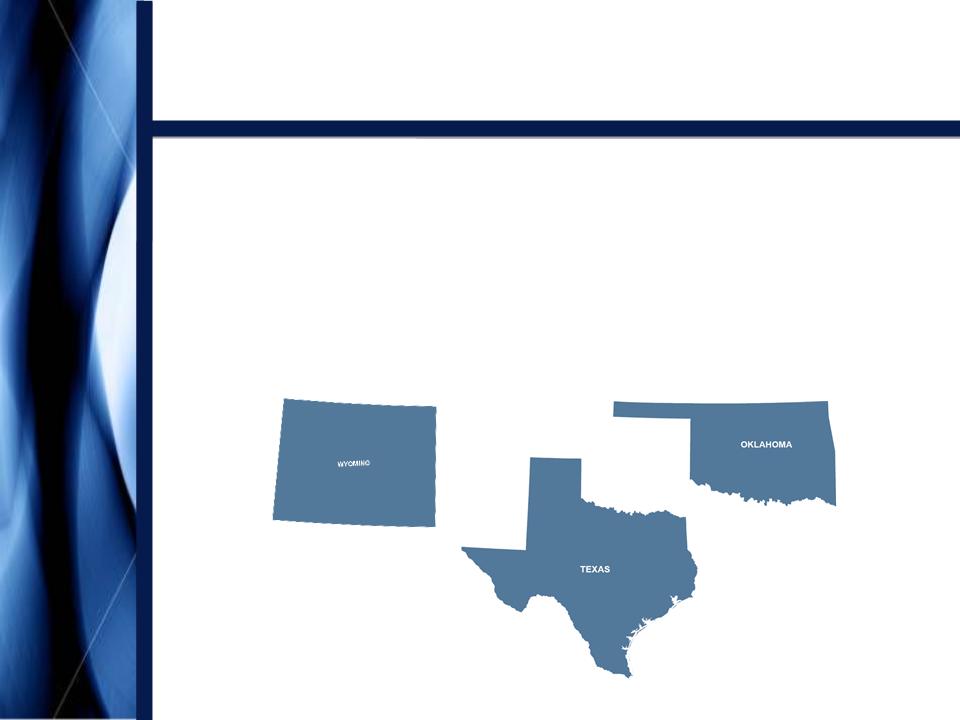
Copano Energy
3
Introduction to Copano
• Serves natural gas producers in three leading producing
regions
regions
• Founded in 1992 - built through more than 50 acquisitions
and major capital projects
and major capital projects
Texas
South Texas and
North Texas
Oklahoma
Central and Eastern Oklahoma
Rocky Mountains
Wyoming’s Powder River Basin

Copano Energy
4
Key Metrics
• Service throughput volumes approximate
2 Bcf per day of natural
gas(1)
gas(1)
• Approximately 6,700 miles of active pipelines
• 7 natural gas processing plants with over 1 Bcf/d of combined
processing capacity
processing capacity
• Equity market cap: $1.1 billion(2)
• Enterprise value: $1.9 billion(2)
• Copano has outperformed its peer group since its IPO with a total
return of 154%(2) compared to the Alerian MLP Total Return Index
(AMZX) total return of 61%(2) over the same period
return of 154%(2) compared to the Alerian MLP Total Return Index
(AMZX) total return of 61%(2) over the same period
(1) Based on 3Q09 results. Includes
unconsolidated affiliates.
(2) As of November 11, 2009.

Copano Energy
5
Copano’s LLC Structure
|
Characteristic |
Typical MLP |
Copano Energy |
Typical Corporation |
|
Non-Taxable Entity |
|
|
|
|
Tax Shield on Distributions |
|
|
|
|
Tax Reporting |
|
|
|
|
General Partner |
|
|
|
|
Incentive Distribution Rights |
|
|
|
|
Voting Rights |
|
|
|
Schedule K-1
Schedule K-1
Form 1099

Copano Energy
6
Agenda
Throughput
Volume Outlook
Volume Outlook
Commodity
Prices and
Margin
Sensitivities
Prices and
Margin
Sensitivities
Capital Access
Distribution Policy
and Outlook
and Outlook

Copano Energy
• Total service throughput volumes decreased 3% from 2Q09 to 3Q09
• Processed volumes decreased 2% from 2Q09 to 3Q09
Total Volume Trends
Note: Includes affiliates, net of intercompany volumes.

Copano Energy
8
Actual Prices: 1/08 - 11/09
Forward Prices as of 11/9/09: 12/09 - 12/13
Oklahoma Natural Gas Price
Outlook
Outlook

Copano Energy
Oklahoma Rich Gas vs. Lean Gas
(1) Full value prior to deduction of Copano’s margin. Excludes
value of condensate and crude oil recovered by the
producer at the wellhead.
producer at the wellhead.
(2) Implied NGL prices are based on a three-year historical
regression analysis.
(3) Assumes 9 GPM gas with a Btu factor of 1.375 processed
at Copano’s cryogenic plant, and field fuel of 6.25%.
(4) Assumes unprocessed gas with a Btu factor of 1.0 and field
fuel of 6%.
9
Prices as of 11/9/09

Copano Energy
10
• Rich gas (primarily Hunton de-watering play)
– Drilling activity increasing due to current
commodity prices and
long-term price outlook
long-term price outlook
– 3 rigs running currently in the Hunton and
12 rigs in other rich
gas areas
gas areas
– High BTU gas, processing upgrade and low
geologic risk
enhance drilling economics, but activity remains subject to
market conditions
enhance drilling economics, but activity remains subject to
market conditions
– 4Q09 volumes are expected to be flat vs.
3Q09
• Lean gas (primarily Woodford Shale and Coalbed methane)
– Drilling activity increasing due to current
commodity prices and
long-term price outlook
long-term price outlook
– 5 rigs currently running
– 4Q09 volumes are expected to be slightly
down from 3Q09
due to lag between drilling and production
due to lag between drilling and production
Oklahoma Volume Outlook
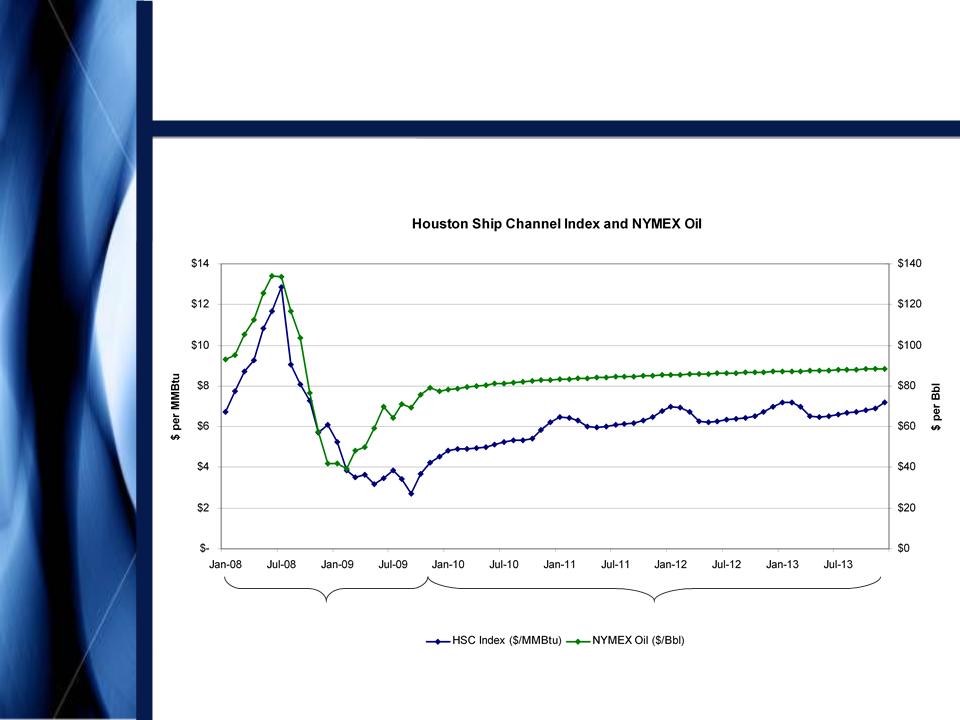
Copano Energy
11
Actual Prices: 1/08 - 11/09
Forward Prices as of 11/9/09: 12/09 - 12/13
South Texas Natural Gas Price
Outlook
Outlook

Copano Energy
12
South Texas Volume Outlook
• Despite reduced rig counts, activity in the traditional supply area
continues
continues
• Pending acquisition of Transco McMullen lateral awaiting FERC
approval
approval
• 4Q09 volumes are expected to be slightly down from 3Q09
• On November 13, 2009, Copano announced a joint venture
with Kinder Morgan to provide gathering, transportation and
processing services to gas producers in the Eagle Ford Shale
with Kinder Morgan to provide gathering, transportation and
processing services to gas producers in the Eagle Ford Shale

Copano Energy
13
North Texas Volume Outlook
• Copano’s Saint Jo processing and treating plant placed in service
in September 2009
in September 2009
– Eliminates the need for third-party processing
– High efficiency and high recovery plant
• 7 rigs running in the area with 12 rigs anticipated in early 2010
• Drilling economics are driven by associated crude oil production
• Production from this area requires a full slate of midstream
services
services
• Based on drilling and fractionation schedules, plant inlet volumes
are expected to decrease slightly in early 2010 before ramping up
to anticipated levels by late 2010
are expected to decrease slightly in early 2010 before ramping up
to anticipated levels by late 2010

Copano Energy
14
Actual Prices: 1/08 - 11/09
Forward Prices as of 11/9/09: 12/09 - 12/13
Rocky Mountains Natural Gas Price
Outlook
Outlook

Copano Energy
15
Rocky Mountains Volume Outlook
• Development of extensive acreage dedication will be driven by drilling
economics and commodity prices
economics and commodity prices
• Timing of dewatering will also drive volume levels
• 4Q09 volumes are expected to be flat vs. 3Q09 due to previously
drilled wells
drilled wells
• For Bighorn, 130 previously drilled wells can be connected with
minimal capital expenditures
minimal capital expenditures
• An additional 70 drilled wells can be connected
with moderate capital
expenditures
expenditures
• On Fort Union, during the third and fourth quarters, roughly 150
MMcf/d was temporarily shut in by producers due to commodity prices;
by mid-October, volumes were back to near pre-shut-in levels
MMcf/d was temporarily shut in by producers due to commodity prices;
by mid-October, volumes were back to near pre-shut-in levels

Copano Energy
Rocky Mountains Takeaway
Capacity Outlook
Capacity Outlook
Source: Bentek Energy, LLC
(1) Historical and future prices as of 11/3/09. 11/9/09
spot: $3.38/Mcf
16
(1)

Copano Energy
17
Commodity Prices and Margin
Sensitivities
Sensitivities
Commodity
Prices and
Margin
Sensitivities
Prices and
Margin
Sensitivities
Distribution Policy
and Outlook
and Outlook
Capital Access
Throughput
Volume Outlook
Volume Outlook

Copano Energy
Oklahoma Commodity Prices
18

Copano Energy
19
Oklahoma Commercial Update
• Third Quarter 2009
– Total service throughput volumes: 260,000 MMBtu/d(1)
– Unit margin: $0.76/MMBtu(2)
– Margins from approximately 75% of contract volumes
are directly
correlated with NGL prices
correlated with NGL prices
– Significant percentage of contract volumes (51%)
contain fee-based
components, including volumes subject to minimum margin provisions
components, including volumes subject to minimum margin provisions
• Operated in full processing mode for third and fourth quarter 2009
to date
to date
(1) Excludes 13,857 MMBtu/d
service throughput for Southern Dome, a majority-owned affiliate.
(2) Refers to Oklahoma segment gross margin ($18.3 million)
divided by Oklahoma service throughput volumes
(268,000 MMBtu/d) for the period. See Appendix for reconciliation of Oklahoma segment gross margin.
(268,000 MMBtu/d) for the period. See Appendix for reconciliation of Oklahoma segment gross margin.

Copano Energy
20
Texas Commodity Prices

Copano Energy
21
Texas Commercial Update
• Third Quarter 2009
– Total service throughput
volumes: 613,000 MMBtu/d(1)
– Unit margin: $0.48/MMBtu(2)
– Margins from approximately 85% of contract volumes
are directly
correlated with NGL prices
correlated with NGL prices
– Approximately 91% of contract volumes have fee-based
components,
including volumes subject to minimum margin provisions
including volumes subject to minimum margin provisions
• Operated in full processing mode for third and fourth quarter 2009
to date
to date
(1) Excludes 72,985 MMBtu/d
service throughput for Webb Duval, a majority-owned affiliate.
(2) Refers to Texas segment gross margin ($26.9 million) divided
by Texas service throughput volumes (613,000
MMBtu/d) for the period. See Appendix for reconciliation of Texas segment gross margin.
MMBtu/d) for the period. See Appendix for reconciliation of Texas segment gross margin.

Copano Energy
22
Texas Fractionation Strategy
• Capacity at NGL fractionation facilities along the Texas Gulf Coast
has become constrained
has become constrained
• For a portion of the second and third quarters of 2009, Copano
realized lower revenue for sales of mixed NGLs from the tailgate of
the Houston Central plant under a short term pricing arrangement
realized lower revenue for sales of mixed NGLs from the tailgate of
the Houston Central plant under a short term pricing arrangement
– In August, Copano entered into a new contract
to sell NGLs from
Houston Central at a higher price
Houston Central at a higher price
• Utilizing Houston Central’s fractionation unit and extensive tailgate
NGL pipelines, Copano plans to produce purity products by 2Q
2010
NGL pipelines, Copano plans to produce purity products by 2Q
2010
– Copano is expanding its de-ethanization capacity
in order to produce
purity ethane and propane
purity ethane and propane
– Iso-butane and normal butane will be sold as
purity products by tank
truck
truck

Copano Energy
23
Rocky Mountains Commercial
Update
Update
• Third Quarter 2009
– Total service throughput volumes:
• Consolidated affiliates (producer services):
157,000 MMBtu/d
• Unconsolidated affiliates:
§ Bighorn: 190,000 MMBtu/d
§ Fort Union: 762,000 MMBtu/d
• All Bighorn and Fort Union margins are fixed fee
• Virtually all producer services margins are fixed margin

Copano Energy
Combined Commodity-Sensitive Segment Margins
and Hedging Settlements
and Hedging Settlements
• Copano’s hedge portfolio supports cash flow stability based on
combined segment gross margins and cash hedging settlements
combined segment gross margins and cash hedging settlements

Copano Energy
25
Commodity-Related Margin
Sensitivities
Sensitivities
Note: Please see Appendix for definitions of processing modes and additional details.
• Matrix reflects 3Q09 wellhead and plant inlet volumes,
adjusted using Copano’s 2009 planning model
adjusted using Copano’s 2009 planning model
(1) Consists of Texas and Oklahoma Segment gross margins.
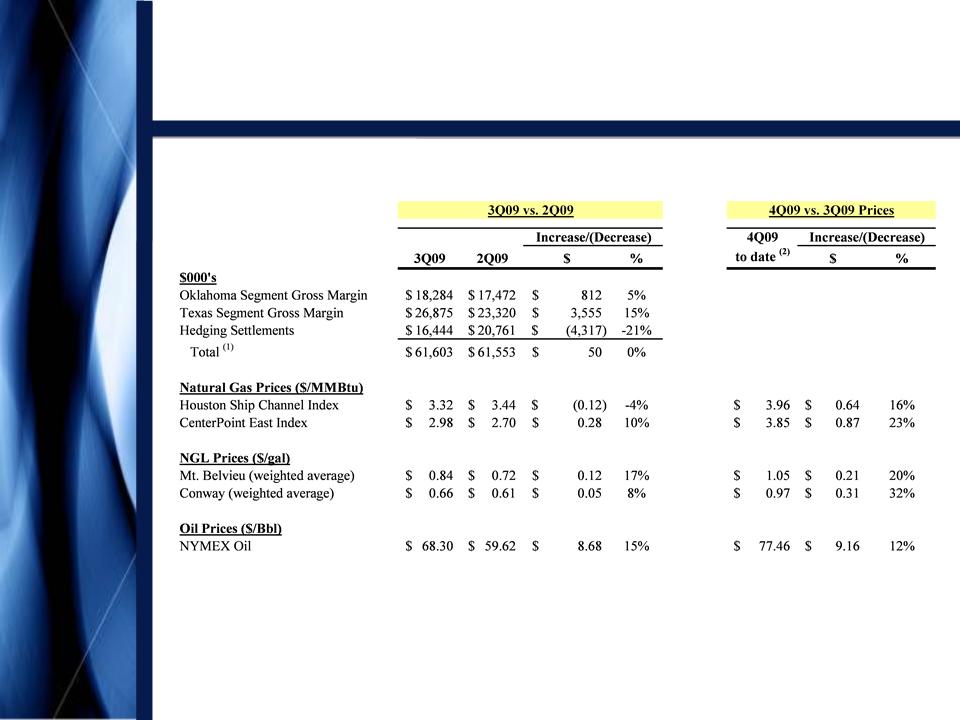
Copano Energy
26
Combined Commodity-Sensitive Segment Margins
and Hedging Settlements
and Hedging Settlements
(1) Does not include non-cash expenses included in Corporate and Other for
purposes of calculating Total Segment
Gross Margin. See Appendix for reconciliation of Total Segment Gross Margin.
Gross Margin. See Appendix for reconciliation of Total Segment Gross Margin.
(2) Reflects prices as of 11/9/09.

Copano Energy
27
Capital Access
Capital Access
Distribution Policy
and Outlook
and Outlook
Commodity
Prices and
Margin
Sensitivities
Prices and
Margin
Sensitivities
Throughput
Volume Outlook
Volume Outlook
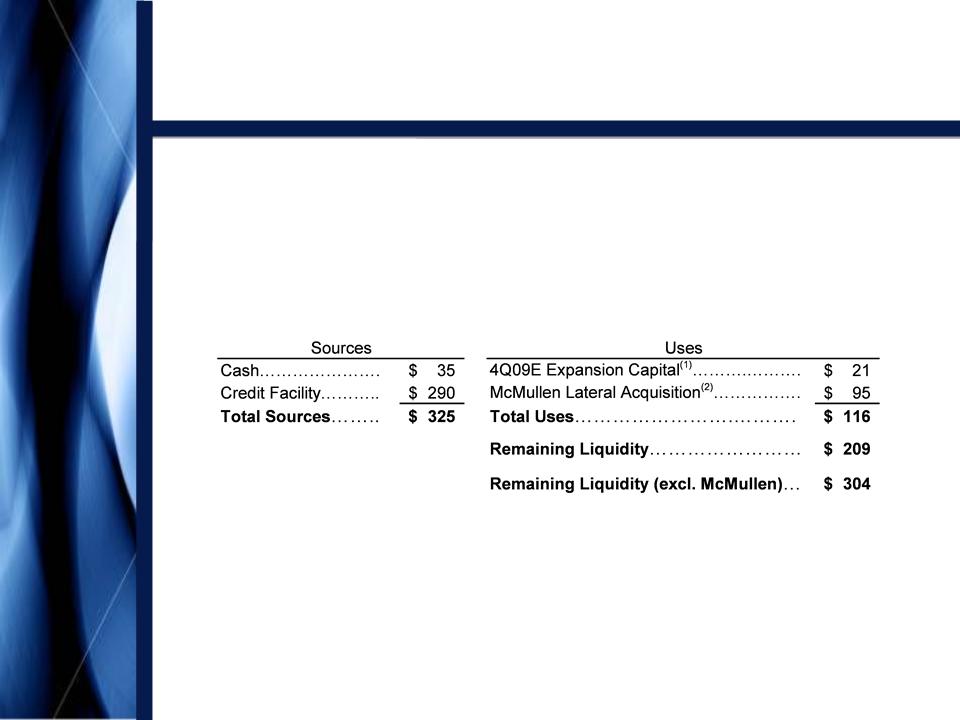
Copano Energy
28
Capital Access
• Copano has no need to access capital markets to support
currently approved projects
currently approved projects
– At September 30, 2009:
($ in millions)
• Debt access available
• Equity access available privately
– Would only make sense for accretive transactions
or projects
(1) Includes Copano’s net share for unconsolidated affiliates. Does
not include future potential acquisitions.
(2) Includes integration costs. The
McMullen Lateral acquisition remains subject to FERC approval.

Copano Energy
29
Liquidity and Debt Facilities
• At September 30, 2009:
– Cash: $35 million
– $550 million revolving credit facility
• Approximately $290 million available
• Remaining term: approximately 3.1 years
• LIBOR + 175 bps
– $582 million senior notes
• $332,665,000 8 ⅛% due 2016
• $249,525,000 7 ¾% due 2018
• Weighted average rate: 7.96%
• Weighted average maturity: 7.4 years

Copano Energy
• Senior Secured Revolving Credit Facility
– $550 million facility with $100 million accordion
– Maintenance tests:
• 5x total debt to defined EBITDA(1) limitation
§ 3.99x at September 30, 2009
• Minimum required interest coverage 2.5x defined
EBITDA
§ 3.41x at September 30, 2009
• Defined EBITDA adds back hedge amortization
and other non-cash
expenses
expenses
– Following an acquisition, Copano may increase
total debt to defined
EBITDA limitation to 5.5x for three quarters
EBITDA limitation to 5.5x for three quarters
• Senior Notes
– Incurrence tests:
• Minimum defined EBITDA to interest test of 2.00x
for debt incurrence
• Minimum defined EBITDA to interest test of 1.75x
for restricted payments
• Defined EBITDA is similar to that for credit
facility
30
Key Debt Terms and Covenants
(1) See this Appendix for reconciliation of defined EBITDA, which is referred
to in our credit facility as
“Consolidated EBITDA.”
“Consolidated EBITDA.”

Copano Energy
31
Distribution Policy and Outlook
Distribution Policy
and Outlook
and Outlook
Capital Access
Commodity
Prices and
Margin
Sensitivities
Prices and
Margin
Sensitivities
Throughput
Volume Outlook
Volume Outlook

Copano Energy
32
Distribution Track Record
• On October 14, 2009, Copano announced a cash distribution for
the third quarter of 2009 of $0.575 per common unit
the third quarter of 2009 of $0.575 per common unit
(3)(4)
(5)
(1) All pre-1Q 2007 distributions are adjusted to reflect Copano’s 3/30/07
two-for-one unit split.
(2) Assumes generic MLP splits with 10%, 25% & 50% increases
in distributable cash flow to LP units resulting in
incremental 13%, 23% and 48% increases in the percentage of total distributable cash flow applicable to the GP.
incremental 13%, 23% and 48% increases in the percentage of total distributable cash flow applicable to the GP.
(3) Actual $0.10 distribution per unit was for the period
from November 15, 2004 through December 31, 2004.
(4) 4Q 2004 annualized.
(5) First nine months of 2009 annualized.

Copano Energy
33
Distribution Outlook
|
Driver |
Potential 2011 - 2012
Annual Incremental Total DCF Impact(1) ($ in millions) |
Comments and Risk Factors |
|
Forward Commodity Prices (3Q09 vs. 2012 forward curve(2) and without hedges) |
$47 |
• Reflects November 2009
forward curve(2) • Future market conditions |
|
North Texas(2) |
$35 - $45 |
• Resource play
• Drilling activity
• Product prices
• New suppliers |
|
Rocky Mountains |
$20 - $40 |
• Resource play
• Drilling activity
• Dewatering rates
• Fort Union expansion
• New projects |
|
South Texas expansion and integration projects, including Transco McMullen Lateral(2) |
$20 - $25 |
• FERC approval
• Product prices
• New attachments |
(1) Compared to 3Q09 annualized levels. See
Appendix for an explanation of how we calculate total distributable
cash flow.
cash flow.
(2) Reflects November 2009 forward price curves with regression-based
NGL prices.

Copano Energy
34
Distribution Outlook
|
Driver |
Potential 2011 - 2012
Annual Incremental Total DCF Impact(1) ($ in millions) |
Comments and Risk Factors |
|
Oklahoma Volumes(2) |
$15 - $20 |
• Resource play
• Drilling activity
• Product prices |
|
Future Acquisitions and Major Projects |
TBD |
• Opportunities
• Execution |
(1) Compared to 3Q09 annualized levels. See
Appendix for an explanation of how we calculate total distributable
cash flow.
cash flow.
(2) Reflects November 2009 forward price curves with regression-based
NGL prices.

Copano Energy
• On October 14, 2009, EnergyPoint Research, Inc. announced
results of its Natural Gas Midstream Services Survey
results of its Natural Gas Midstream Services Survey
• Copano placed first overall among 16 midstream energy
companies. Copano also rated first in many categories for
gathering and processing/treating
companies. Copano also rated first in many categories for
gathering and processing/treating
#1 in Customer Satisfaction

Copano Energy
• Current cash flow trends remain solid
• Forward market prices should drive increased drilling activity in our
cost-competitive operating regions
cost-competitive operating regions
• Copano’s liquidity and access to capital remain strong
• Copano continues to enjoy an abundant opportunity environment
36
Conclusions

Copano Energy
37
Appendix

Copano Energy
38
Oklahoma Assets
Appendix

Copano Energy
South Texas Assets
Appendix
(1) The McMullen Lateral acquisition remains subject to FERC approval.
(1)

Copano Energy
40
North Texas Assets
Appendix

Copano Energy
Rocky Mountains Assets
Appendix

Copano Energy
42
Processing Modes
• Full Recovery
• Ethane Rejection
• Conditioning Mode
→ Texas and Oklahoma - If the value of
recovered NGLs exceeds the fuel and gas
shrinkage costs of recovering NGLs
recovered NGLs exceeds the fuel and gas
shrinkage costs of recovering NGLs
→ Texas - If the value of recovered NGLs is less
than the fuel and gas shrinkage cost of
recovering NGLs (available at Houston
Central plant and at Saint Jo plant in North
Texas)
than the fuel and gas shrinkage cost of
recovering NGLs (available at Houston
Central plant and at Saint Jo plant in North
Texas)
→ Texas and Oklahoma - If the value of ethane
is less than the fuel and shrinkage costs to
recover ethane (in Oklahoma, ethane
rejection at Paden plant is limited by nitrogen
rejection facilities)
is less than the fuel and shrinkage costs to
recover ethane (in Oklahoma, ethane
rejection at Paden plant is limited by nitrogen
rejection facilities)
Appendix

Copano Energy
43
Oklahoma Contract Mix
• Third quarter 2009 contract mix(1)
(1) Source: Copano Energy internal financial planning models for consolidated
subsidiaries.
(2) Excludes 13,857 MMBtu/d service throughput for Southern
Dome, a majority-owned affiliate.

Copano Energy
44
Oklahoma Net Commodity
Exposure
Exposure
Note: See explanation of processing modes in this Appendix. Values reflect rounding.
(1) Source: Copano
Energy internal financial planning models for consolidated subsidiaries.
(2) Ethane rejection at Paden plant is limited by nitrogen
rejection facilities.
(3) Reflects impact of producer delivery point allocations,
offset by field condensate collection and stabilization.
Appendix

Copano Energy
45
Oklahoma Net Commodity
Exposure(1)
Exposure(1)
Appendix
Note: See explanation of processing modes in this Appendix.
(1) Source: Copano
Energy internal financial planning models for consolidated subsidiaries. Based on 3Q09 daily
wellhead/plant inlet volumes.
wellhead/plant inlet volumes.

Copano Energy
46
Oklahoma Commodity Price
Sensitivities
Sensitivities
• Oklahoma segment gross margins excluding hedge
settlements
settlements
– Matrix reflects 3Q09 volumes, adjusted using
Copano’s 2009
planning model
planning model
Appendix

Copano Energy
47
Texas Contract Mix
• Third quarter 2009 contract mix(1)
Appendix
(1) Source: Copano
Energy internal financial planning models for consolidated subsidiaries.
(2) Excludes 72,985 MMBtu/d service throughput for Webb Duval,
a majority-owned affiliate.

Copano Energy
48
Texas Net Commodity Exposure
Note: See explanation of processing modes in this Appendix.
(1) Source: Copano
Energy internal financial planning models for consolidated subsidiaries. Based on 3Q09 daily
wellhead/plant inlet volumes.
wellhead/plant inlet volumes.
(2) Fractionation at Houston Central processing plant permits
significant reductions in ethane recoveries in ethane
rejection mode and full ethane rejection in conditioning mode. To optimize profitability, plant operations can
also be adjusted to partial recovery mode.
rejection mode and full ethane rejection in conditioning mode. To optimize profitability, plant operations can
also be adjusted to partial recovery mode.
(3) At the Houston Central processing plant, pentanes+ may
be sold as condensate.
Appendix

Copano Energy
49
Texas Net Commodity Exposure(1)
Note: See explanation of processing modes in this Appendix.
(1) Source: Copano
Energy internal financial planning models for consolidated subsidiaries. Based on 3Q09 daily
wellhead/plant inlet volumes.
wellhead/plant inlet volumes.

Copano Energy
50
Texas Commodity Price
Sensitivities
Sensitivities
• Texas segment gross margins excluding hedge settlements
– Matrix reflects 3Q09 volumes and operating conditions,
adjusted using Copano’s 2009 planning model
adjusted using Copano’s 2009 planning model
Appendix

Copano Energy
51
Rocky Mountains Sensitivities
Appendix
Note: See this Appendix for reconciliation of Adjusted EBITDA. Values reflect rounding.
(1) Impact on Adjusted EBITDA based on Copano’s interest
in the unconsolidated affiliate.
• Third Quarter 2009
– Adjusted EBITDA volume sensitivity (positive
or negative impact)
• Consolidated (producer services): 10,000 MMBtu/d
= $28,000
• Unconsolidated affiliates:
§ Bighorn: 10,000 MMBtu/d = $249,000(1)
§ Fort Union: 10,000 MMBtu/d = $70,000(1)

Copano Energy
52
Hedging Impact
of Commodity Price Sensitivities
of Commodity Price Sensitivities
• Commodity hedging program supplements cash flow in 2009
through 2011 during less favorable commodity price periods
through 2011 during less favorable commodity price periods
Appendix
Note: For calendar 2012, Copano currently has WTI crude puts of 300 barrels per day with a strike price of $79/Bbl.

Copano Energy
53
Hedging Impact
• Fourth Quarter 2009 NGLs Hedge Settlement Matrix
Note: All hedge instruments are reported in Copano’s SEC filings. Hedge settlements are based on monthly average
Mt. Belvieu NGL and NYMEX WTI prices. Positive amounts reflect payments from hedge counterparties under
swap and put option instruments. Negative amounts reflect payments to hedge counterparties under swap
instruments.
Mt. Belvieu NGL and NYMEX WTI prices. Positive amounts reflect payments from hedge counterparties under
swap and put option instruments. Negative amounts reflect payments to hedge counterparties under swap
instruments.
Appendix

Copano Energy
54
Hedging Impact
• 2010 NGLs Hedge Settlement Matrix
Note: All hedge instruments are reported in Copano’s SEC filings. Hedge settlements are based on monthly average
Mt. Belvieu NGL and NYMEX WTI prices. Positive amounts reflect payments from hedge counterparties under
swap and put option instruments. Negative amounts reflect payments to hedge counterparties under swap
instruments.
Mt. Belvieu NGL and NYMEX WTI prices. Positive amounts reflect payments from hedge counterparties under
swap and put option instruments. Negative amounts reflect payments to hedge counterparties under swap
instruments.
Appendix
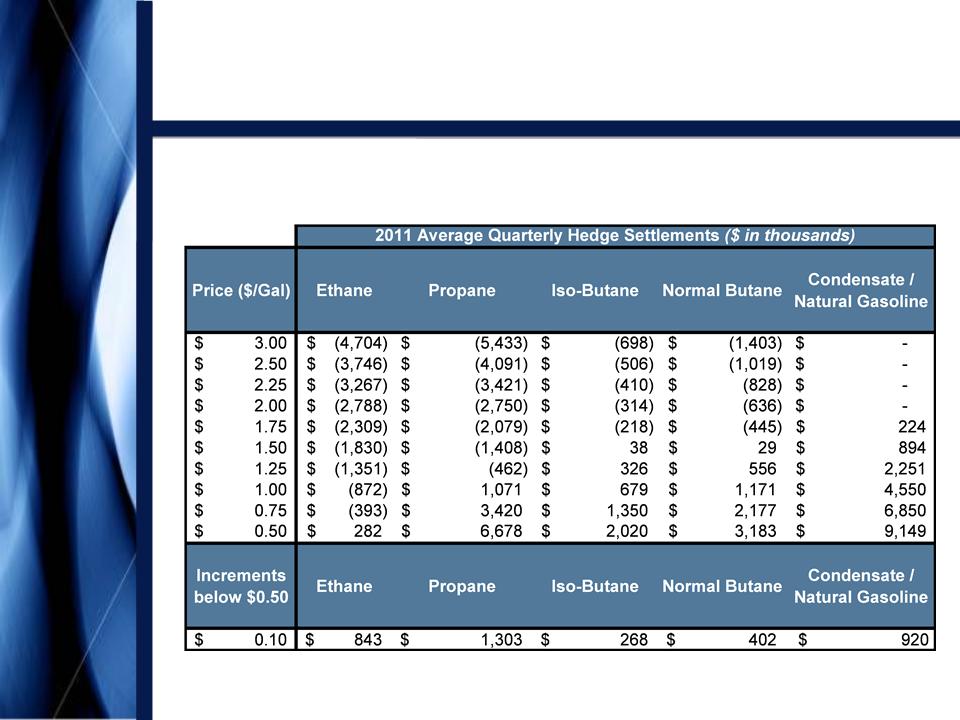
Copano Energy
55
Hedging Impact
• 2011 NGLs Hedge Settlement Matrix
Note: All hedge instruments are reported in Copano’s SEC filings. Hedge settlements are based on monthly average
Mt. Belvieu NGL and NYMEX WTI prices. Positive amounts reflect payments from hedge counterparties under
swap and put option instruments. Negative amounts reflect payments to hedge counterparties under swap
instruments.
Mt. Belvieu NGL and NYMEX WTI prices. Positive amounts reflect payments from hedge counterparties under
swap and put option instruments. Negative amounts reflect payments to hedge counterparties under swap
instruments.
Appendix
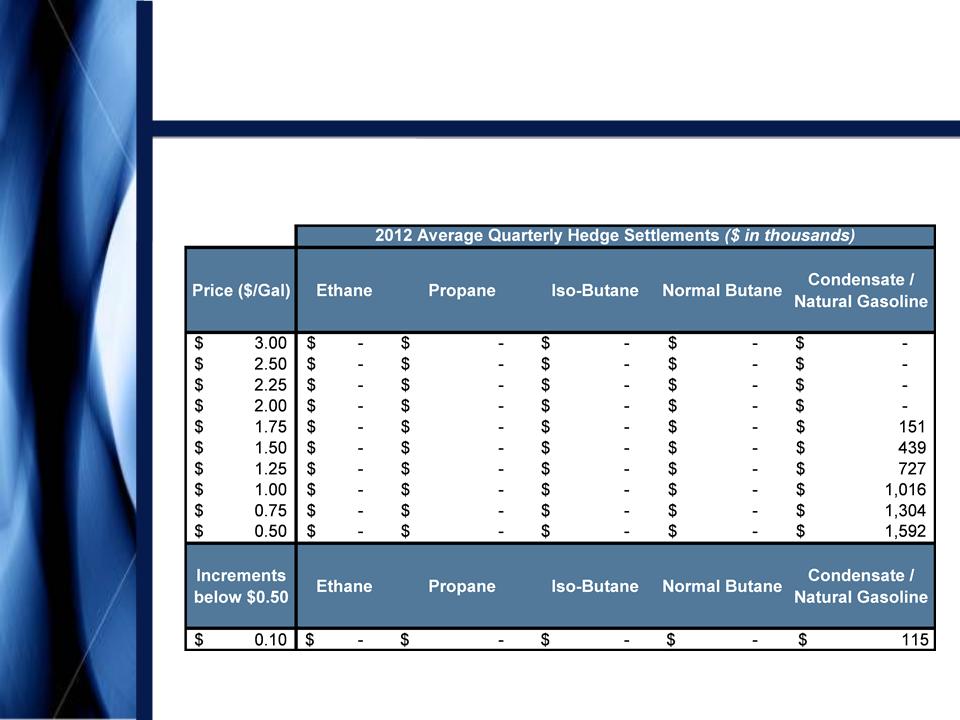
Copano Energy
56
Hedging Impact
• 2012 NGLs Hedge Settlement Matrix
Note: All hedge instruments are reported in Copano’s SEC filings. Hedge settlements are based on monthly average
Mt. Belvieu NGL and NYMEX WTI prices. Positive amounts reflect payments from hedge counterparties under
swap and put option instruments. Negative amounts reflect payments to hedge counterparties under swap
instruments.
Mt. Belvieu NGL and NYMEX WTI prices. Positive amounts reflect payments from hedge counterparties under
swap and put option instruments. Negative amounts reflect payments to hedge counterparties under swap
instruments.
Appendix

Copano Energy
57
Hedging Impact
• 2009 - 2011 Natural Gas Hedge Settlement Matrix
Note: All hedge instruments are reported in Copano’s SEC filings. Hedge settlements are based on first of the month
Houston Ship Channel and CenterPoint East natural gas prices. Positive amounts reflect payments from hedge
counterparties under call and put option instruments.
Houston Ship Channel and CenterPoint East natural gas prices. Positive amounts reflect payments from hedge
counterparties under call and put option instruments.
Appendix

Copano Energy
58
• At September 30, 2009:
– Moody’s
• Corporate Family Rating: Ba3
• Senior Unsecured Rating: B1
• Outlook: Stable
– Standard & Poor’s
• Corporate Credit Rating: BB-
• Senior Unsecured Rating: B+
• Outlook: Stable
Credit Ratings

Copano Energy
59
Limited Liability Company Agreement
• Distributions based on “Available Cash”
– Cash on hand at the end of a quarter less reserves
established
by the Board
by the Board
– Board may increase or decrease reserves quarterly
• Since IPO and as of September 30, 2009:
– Initial available cash and reserve at IPO: $20
million
– Cumulative cash from operations: $476 million
– Cumulative distributions: $376 million
– Cumulative reserves established by the Board:
$150 million
Appendix

Copano Energy
60
Oil Price Trends
(1) As of November 9, 2009.
Appendix
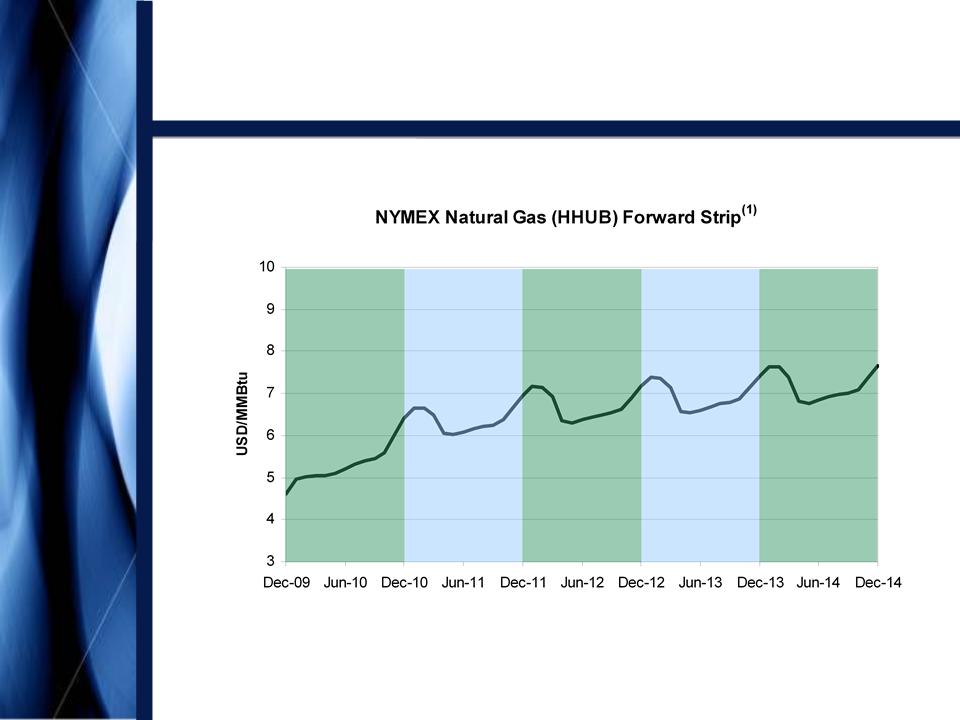
Copano Energy
61
Natural Gas Price Trends
(1) As of November 9, 2009.
Appendix

Copano Energy
62
Reconciliation of Non-GAAP
Financial Measures
Financial Measures
Segment Gross Margin and Total Segment Gross Margin
• We define segment gross margin, with respect to a Copano operating segment, as segment revenue less cost of sales. Cost
of sales includes the following:
cost of natural gas and NGLs purchased from third parties, cost of natural gas and NGLs purchased from affiliates, cost of crude oil purchased from third
parties, costs paid to third parties to transport volumes and costs paid to affiliates to transport volumes. Total segment gross margin is the sum of the
operating segment gross margins and the results of Copano’s risk management activities that are included in Corporate and other. We view total segment
gross margin as an important performance measure of the core profitability of our operations. Segment gross margin allows Copano’s senior management
to compare volume and price performance of the segments and to more easily identify operational or other issues within a segment. The GAAP measure
most directly comparable to total segment gross margin is operating income.
cost of natural gas and NGLs purchased from third parties, cost of natural gas and NGLs purchased from affiliates, cost of crude oil purchased from third
parties, costs paid to third parties to transport volumes and costs paid to affiliates to transport volumes. Total segment gross margin is the sum of the
operating segment gross margins and the results of Copano’s risk management activities that are included in Corporate and other. We view total segment
gross margin as an important performance measure of the core profitability of our operations. Segment gross margin allows Copano’s senior management
to compare volume and price performance of the segments and to more easily identify operational or other issues within a segment. The GAAP measure
most directly comparable to total segment gross margin is operating income.
Appendix

Copano Energy
63
Reconciliation of Non-GAAP
Financial Measures
Financial Measures
Adjusted EBITDA
• We define EBITDA as net income (loss) plus interest expense, provision for income taxes and depreciation and amortization expense. Because
a portion of
our net income (loss) is attributable to equity in earnings (loss) from our equity investees (which include Bighorn, Fort Union, Webb Duval and Southern
Dome), our management also calculates Adjusted EBITDA to reflect the depreciation and amortization expense embedded in equity in earnings (loss) from
unconsolidated affiliates. Specifically, our management determines Adjusted EBITDA by adding to EBITDA (i) the amortization expense attributable to the
difference between our carried investment in each unconsolidated affiliate and the underlying equity in its net assets, (ii) the portion of each unconsolidated
affiliate’s depreciation and amortization expense, which is proportional to our ownership interest in that unconsolidated affiliate and (iii) the portion of each
unconsolidated affiliate’s interest and other financing costs, which is proportional to our ownership interest in that unconsolidated affiliate.
our net income (loss) is attributable to equity in earnings (loss) from our equity investees (which include Bighorn, Fort Union, Webb Duval and Southern
Dome), our management also calculates Adjusted EBITDA to reflect the depreciation and amortization expense embedded in equity in earnings (loss) from
unconsolidated affiliates. Specifically, our management determines Adjusted EBITDA by adding to EBITDA (i) the amortization expense attributable to the
difference between our carried investment in each unconsolidated affiliate and the underlying equity in its net assets, (ii) the portion of each unconsolidated
affiliate’s depreciation and amortization expense, which is proportional to our ownership interest in that unconsolidated affiliate and (iii) the portion of each
unconsolidated affiliate’s interest and other financing costs, which is proportional to our ownership interest in that unconsolidated affiliate.
• External users of our financial statements such as investors, commercial banks and research analysts use EBITDA or Adjusted EBITDA, and our
management uses Adjusted EBITDA, as a supplemental financial measure to assess:
management uses Adjusted EBITDA, as a supplemental financial measure to assess:
– The financial performance of our assets without
regard to financing methods, capital structure or historical cost basis;
– The ability of our assets to generate cash sufficient
to pay interest costs and support our indebtedness;
– Our operating performance and return on capital
as compared to those of other companies in the midstream energy sector, without regard to
financing or capital structure; and
financing or capital structure; and
– The viability of acquisitions and capital expenditure
projects and the overall rates of return on alternative investment opportunities.
• The following table presents a reconciliation of the portion of our EBITDA and Adjusted EBITDA attributable to each of our segments to the
GAAP financial
measure of net income (loss):
measure of net income (loss):
Appendix

Copano Energy
64
Reconciliation of Non-GAAP
Financial Measures
Financial Measures
Consolidated EBITDA
§ EBITDA is also a financial measure that, with negotiated pro forma adjustments relating to acquisitions completed during the
period, is reported to our lenders as Consolidated EBITDA and is used to compute our financial covenants under our senior
secured revolving credit facility.
period, is reported to our lenders as Consolidated EBITDA and is used to compute our financial covenants under our senior
secured revolving credit facility.
§ The following table presents a reconciliation of the non-GAAP financial measure of Consolidated EBITDA to the GAAP
financial measure of net income (loss):
financial measure of net income (loss):
Appendix

Copano Energy
65
Definitions of Non-GAAP
Financial Measures
Financial Measures
Total Distributable Cash Flow
§ We define total distributable cash flow as net income plus: (i) depreciation, amortization and impairment expense (including
amortization expense relating to the option component of our risk management portfolio); (ii) cash distributions received from
investments in unconsolidated affiliates and equity losses from such unconsolidated affiliates; (iii) provision for deferred
income taxes; (iv) the subtraction of maintenance capital expenditures; (v) the subtraction of equity in earnings from
unconsolidated affiliates and (vi) the addition of losses or subtraction of gains relating to other miscellaneous non-cash
amounts affecting net income for the period, such as equity-based compensation, mark-to-market changes in derivative
instruments, and our line fill contributions to third-party pipelines and gas imbalances. Maintenance capital expenditures are
capital expenditures employed to replace partially or fully depreciated assets to maintain the existing operating capacity of
our assets and to extend their useful lives, or other capital expenditures that are incurred in maintaining existing system
volumes and related cash flows.
amortization expense relating to the option component of our risk management portfolio); (ii) cash distributions received from
investments in unconsolidated affiliates and equity losses from such unconsolidated affiliates; (iii) provision for deferred
income taxes; (iv) the subtraction of maintenance capital expenditures; (v) the subtraction of equity in earnings from
unconsolidated affiliates and (vi) the addition of losses or subtraction of gains relating to other miscellaneous non-cash
amounts affecting net income for the period, such as equity-based compensation, mark-to-market changes in derivative
instruments, and our line fill contributions to third-party pipelines and gas imbalances. Maintenance capital expenditures are
capital expenditures employed to replace partially or fully depreciated assets to maintain the existing operating capacity of
our assets and to extend their useful lives, or other capital expenditures that are incurred in maintaining existing system
volumes and related cash flows.
§ Total distributable cash flow is a significant performance metric used by senior management to compare basic cash flows
generated by us (prior to the establishment of any retained cash reserves by our Board of Directors) to the cash distributions
we expect to pay our unitholders, and it also correlates with the metrics of our existing debt covenants. Using total
distributable cash flow, management can quickly compute the coverage ratio of estimated cash flows to planned cash
distributions. Total distributable cash flow is also an important non-GAAP financial measure for our unitholders because it
serves as an indicator of our success in providing a cash return on investment — specifically, whether or not we are
generating cash flow at a level that can sustain or support an increase in our quarterly distribution rates. Total distributable
cash flow is also used by industry analysts with respect to publicly traded partnerships and limited liability companies
because the market value of such entities’ equity securities is significantly influenced by the amount of cash they can
distribute to unitholders.
generated by us (prior to the establishment of any retained cash reserves by our Board of Directors) to the cash distributions
we expect to pay our unitholders, and it also correlates with the metrics of our existing debt covenants. Using total
distributable cash flow, management can quickly compute the coverage ratio of estimated cash flows to planned cash
distributions. Total distributable cash flow is also an important non-GAAP financial measure for our unitholders because it
serves as an indicator of our success in providing a cash return on investment — specifically, whether or not we are
generating cash flow at a level that can sustain or support an increase in our quarterly distribution rates. Total distributable
cash flow is also used by industry analysts with respect to publicly traded partnerships and limited liability companies
because the market value of such entities’ equity securities is significantly influenced by the amount of cash they can
distribute to unitholders.
Appendix

Copano Energy
NASDAQ: CPNO
November 2009
